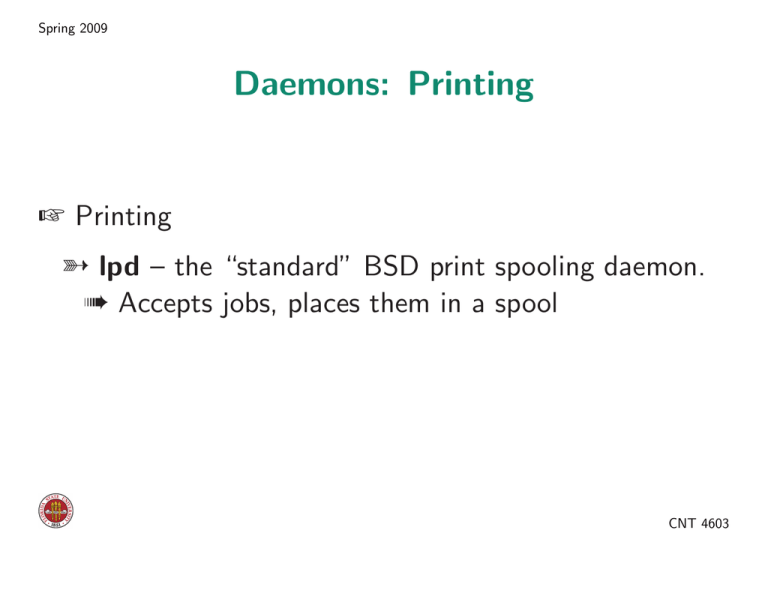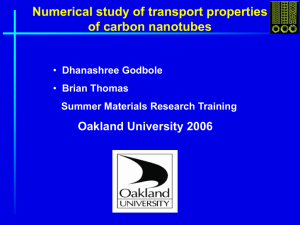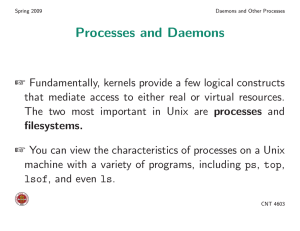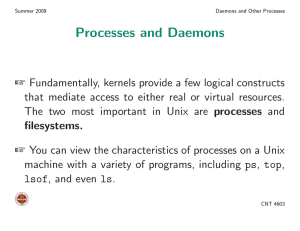Daemons: Printing + Printing à Accepts jobs, places them in a spool
advertisement

Spring 2009 Daemons: Printing + Printing ó lpd – the “standard” BSD print spooling daemon. à Accepts jobs, places them in a spool CNT 4603 Spring 2009 Daemons: Printing à If lpd is operating locally, then it does the interaction with printer (these days, almost always via a filter that does the actual communication) à If not local, then (unsurprisingly) the daemon sends the job to another machine; the lpd protocol (RFC 1179, see http://www.ietf.org/rfc/rfc1179.txt) was not a great design success CNT 4603 Spring 2009 Daemons: Printing ó lpsched – the “standard” ATT version of lpd ; it is more complex to administer (see Chapter 23 of USAH) and, while it was less likely to wander off the reservation once it is in operation, configuration can be much more interesting and problem-laden than lpd. lpsched uses the same RFC 1179 protocol, which it inherited from BSD. CNT 4603 Spring 2009 Daemons: Printing ó lprng – an open source lpd replacement, includes a “Printing Cookbook” for people who like details. However, lprng doesn’t seem to be gaining popularity; cups instead seems to have overtaken it CNT 4603 Spring 2009 Daemons: Printing ó cups – a very popular open source replacement which disposes of the problematic RFC 1179 protocol, replacing it with IPP (RFC2567 (good explanation of the overall view of the protocol’s design), RFC2568, RFC2569, RFC2639, RFC2910, RFC2911, RFC3196, RFC3239, RFC3380, RFC3381, RFC3382, RFC3391, RFC3510, RFC3712, RFC3995, RFC3996, RFC3997, RFC3998) CNT 4603 Spring 2009 Daemons: Printing ó Windows 2003/2008 – See Chapter 13 (page 1059) of W2K3 on how to configure and troubleshoot network print services. In particular, there is a nice 7 step summary on page 1064 of the printing process. CNT 4603 Spring 2009 Daemons: MTAs/MSAs + Mail Transfer Agents (MTAs, see for instance RFC2821) and Mail Submission Agents (MSAs, RFC2476) CNT 4603 Spring 2009 Daemons: MTAs/MSAs + sendmail + Routes local and network mail. Acts as MTA (and as an MSA listening on port 587), sendmail is one of the Internet email backbone workhorse programs. CNT 4603 Spring 2009 Daemons: MTAs/MSAs + One of the largest and historically “buggiest” daemons, although the latest versions have security patches aggressively developed as needed (it is always a good idea to check http://www.sendmail.org for the latest on sendmail security.) + Configuration information is kept these days in the subdirectory /etc/mail. CNT 4603 Spring 2009 Daemons: MTAs/MSAs + The file /etc/mail/sendmail.cf is a set of rewriting rules for modifying addresses; luckily tools exist to automate creation of this file (basically, you use a “makefile” that rewrites a “.mc” file into a “.cf” file. Check http://www.sendmail.org/ for lots more information – the op.ps manual is the canonical reading material, although the O’Reilly book is easier.) CNT 4603 Spring 2009 Daemons: MTAs/MSAs + sendmail is covered some in Chapter 19 of USAH, plus there is an entire O’Reilly & Associates book is dedicated to sendmail . CNT 4603 Spring 2009 Daemons: MTAs/MSAs + Current, sendmail 8.14 is quite popular as an MTA. The ability to use a bolt-on “milter” (mail filter) was added (see http://www.milter.org), and now sendmail is probably the most flexible MTA when dealing with working at a message level; milters can detect and reject spam, they can check for legitimate users even for just forwarding MTAs, they can be implemented in C, C++, Perl, and Python. CNT 4603 Spring 2009 Daemons: MTAs/MSAs + postfix + postfix comes from IBM, and has become probably the second most popular MTA. (http://www.postfix.org) + It is very powerful: and postfix now does handle milters. It does have a large set of configuration files that work very well together. CNT 4603 Spring 2009 + The configuration is typically in /etc/postfix. CNT 4603 Spring 2009 Daemons: MTAs/MSAs + qmail - Dan Bernstein’s MTA (http://www.qmail.org). + smail - an older, less popular MTA from GNU; however, it has been very stable + exim - an MTA from Cambridge, gaining in popularity, now found in many Linux distributions such as RedHat (CentOS) and Debian (where it is now the default MTA) CNT 4603 Spring 2009 + Exchange - the enterprise Windows email server from Microsoft CNT 4603 Spring 2009 Daemons: MTAs/MSAs + SA relevance: + Mail service is the most popular and, arguably, most important service on your system (along with web service) + Users get upset when mail does not work + As with any other network service, you must keep up with the latest security patches CNT 4603 Spring 2009 Daemons: MTAs/MSAs + Configuring and tuning sendmail can take a lot of SA time, although generally using the m4 files allow deployment with just a little bit of effort — for a GUI approach, look at webmin at http://www.webmin.com, for instance CNT 4603 Spring 2009 Daemons: MTAs/MSAs + Very important these days in both server and client support is anti-spam and anti-virus protection. From a server perspective, the biggest tools are + MailScanner (http://www.mailscanner.info) (server only) + clamav (http://www.clamav.net) (runs on both client and server) CNT 4603 Spring 2009 + razor (http://razor.sourceforge.net) (generally invoked within SpamAssassin) + dcc (http://www.dcc-servers.net/dcc) invoked within SpamAssassin) (generally + SpamAssassin (http://spamassassin.apache.org/) (general run on servers) + Realtime Blackhole List (RBL) source, (for instance, http://www.spamhaus.org) (most powerful when used at the initial MTA contact, although SpamAssassin CNT 4603 Spring 2009 can consult RBLs and we do use it both ways in the department) CNT 4603 Spring 2009 NFS - Network File Service + NFS was developed by Sun and is now used by many UNIX/Linux systems + It allows file access across the network as if the files were local CNT 4603 Spring 2009 NFS - Network File Service + NFS exists as a number of daemons - nfsd, biod, etc., as well as in kernel file system code + NFS is covered in Ch. 17 of USAH and we will cover it in more detail in a later lecture CNT 4603 Spring 2009 Yellow pages (NIS and NIS+) + Allows key system files (“maps”) to be shared over the net using a UNIX/Linux dbm database and a client/server model running on top of RPC. 1. 2. 3. 4. ‘‘ypcat passwd | more’’ *vs* ‘‘more /etc/passwd’’ /var/yp on the YP server and clients YP == NIS (Network Information Service) CNT 4603 Spring 2009 Yellow pages (NIS and NIS+) + ypserv - server daemon 1. One master (see via “ypwhich”) 2. Serves a YP domain – “csdept” via “domainname” CNT 4603 Spring 2009 Yellow pages (NIS and NIS+) 3. NOTE: YP domain name != DNS domain name != Windows domain (The term “domain” is, unfortunately, overloaded and overused in the computing field.) + ypbind - client daemon: Locates a yp server and serves up the maps CNT 4603 Spring 2009 Yellow pages (NIS and NIS+) + SA RELEVANCE: You may come across the use of NIS or NIS+ in future jobs. The idea is a good one, but the implementation is now somewhat dated and insecure. Systems are moving away from NIS/NIS+ and into more versatile directory services, such as the Lightweight Directory Access Protocol (LDAP). More on generalized directory services and LDAP later. Pp. 521-531 in USAH cover NIS/NIS+ in more detail. CNT 4603 Spring 2009 + Sun has been lukewarm in trying to move people away from NIS+. CNT 4603 Spring 2009 ftpd + ftpd is the File Transfer Protocol daemon, used by FTP client software to transfer files. As with sendmail, keeping up with security patches is critical in ftp implementations (the complex command set generally gives hackers plenty of places to look for flaws). On UNIX/Linux systems, a popular FTP implementation has been wu-ftpd (which has had many security flaws.) CNT 4603 Spring 2009 ftpd + ftpd is now being widely replaced by programs running over SSH/SSL such as sftpd, which gives a ftp-like capability over SSH (we will talk later more about sshd). While the user commands are similiar, the underlying protocol is quite different (see http://tools.ietf.org/html/draft-ietf-secsh-filexfer10.txt for more details.) Security is much better since plaintext passwords are not sent over IP as they were CNT 4603 Spring 2009 for the old protocol. CNT 4603 Spring 2009 ftpd + The old ftp protocol is specifed in RFC959. + However, old ftp is not going away. There is still a useful place in Internet space for anonymous ftp, where the old version is better than more secure versions. If you don’t care about security (and you don’t with anonymous ftp), then why pay the overhead costs of using secure protocols? CNT 4603 Spring 2009 Remote execution daemons + A number of commands exist that permit a closer coupling between servers that support them. First there was telnet and ftp, then came the “r” command. Examples include: rsh (remote shell) and rlogin (remote login). A number of inetd-managed daemons exist to handle these services; strongly advised to disable all the “r” daemons since they are insecure. CNT 4603 Spring 2009 Remote execution daemons (the “r” commands) + In these security-conscious days you must move away from the “r” commands and into more secure equivalents, such as ssh (secure shell) and scp/sftp (secure copy) + Ironically, original telnet and ftp are still quite useful! CNT 4603 Spring 2009 named (and djbdns) + named is a common name for the popular Domain Name Server daemon and it comes as part of the BIND package, originally from UC Berkeley. We will discuss DNS later, but in short named provides: ó Mapping of host names to IP addresses ó Mapping of IP addresses to host names CNT 4603 Spring 2009 named (and djbdns) ó Other mappings ó A distributed, reasonably robust protocol (RFC1034) ó The standard BIND distribution has had some severe criticism; Dan Bernstein has an alternative package called CNT 4603 Spring 2009 named (and djbdns) djbdns which is more secure (and you still can receive $500 if you find a security lapse; see the offer at http://cr.yp.to/djbdns/guarantee.html) We will talk more about djbdns, but it lacks some features that many system administrators regard as critical. However, Dr. Bernstein has recently revised his licensing and very active development has picked up, especially in light of the recent spotlight cast on BIND’s woes. CNT 4603 Spring 2009 named (and djbdns) + SA RELEVANCE: DNS is a major SA task, if you control your own domain. Both UNIX/Linux and 2003/2008 can act as a DNS server (as well as other operating systems). CNT 4603 Spring 2009 fingerd The finger protocol is an older method for getting information about users. As with the “r” commands, most consider fingerd (and the finger command) to be too problematic and remote finger should be disabled. CNT 4603 Spring 2009 httpd + Many web servers exist, both in the public domain and commercially. One of the most popular, Apache, uses the daemon name of httpd. It offers a great variety of services and enhancements; the relatively recent rewrite from 1.x to 2.x his finally gaining widespread acceptance (a few operating system distributions had been lingering on 1.3, which is still available as 1.3.41). See http://httpd.apache.org CNT 4603 Spring 2009 httpd + The management of web service is a fundamental service provided by the administrator. usually system + The popular Windows 2003/2008 web server equivalent from Microsoft is IIS. Historically, it was ridden with serious security lapses, but more recent versions are vastly improved. CNT 4603 Spring 2009 httpd + There are lightweight servers also, such as thttpd (http://www.acme.com/software/thttpd) and specialized ones such that allow development in SOAPlike manner (see Perl http://www.cpan.org (JOAP, HTTP-Server-Simple, etc.)) CNT 4603 Spring 2009 Databases: LDAP servers + The main open source choice for UNIX/Linux-based LDAP service is OpenLDAP (http://www.openldap.org). The daemon process is called slapd, and it supports replication (via slurpd or more recently, syncrepl), a wide variety of backends (including relational databases such as MySQL and PostgreSQL.) CNT 4603 Spring 2009 Databases: LDAP servers + However, Netscape has partnered with Red Hat (December 2005) to provide its Directory Server (http://www.redhat.com/directory server/) as an open source LDAP server. It’s technically somewhat interesting; its ability to handle very arbitrary backends (such as MySQL and Postgres) is more flexible than the openldap approach of “metadata”. CNT 4603 Spring 2009 Databases: relational + MySQL – fast, becoming more featureful in version 5; the company itself was recently bought out by Sun. Expect to find the daemon mysqld in the process table. The client is mysql. Only a small amount of text file configuration in the poorly named file /etc/my.cnf; the rest is resident in the database. CNT 4603 Spring 2009 Databases: relational + PostgreSQL – very featureful, (ironically, it was supported by Sun well before Sun’s acquisition of MySQL). Grep for “post” when you are looking for its daemons, which typically have “postmaster” and other keywords with “post” in them. The client is psql. Surprising amount of text configuration files, such as hba.conf. Generally not as fast as MySQL. CNT 4603 Spring 2009 Time: ntpd + Since the 1990s, we have had a Network Time Protocol (NTP) and a structure of servers to propagate it. (Work goes back to the 1980s, but the first popular daemon implementation popped up in the 1990s.) It keeps our machines with a few milliseconds with a simple network of servers. (Also note that older versions of NTP actually suffer from a “year 2036” problem, like Unix suffers from a “year 2038” problem.) CNT 4603 Spring 2009 Miscellaneous UNIX/Linux daemons + A number of other UNIX/Linux daemons have been around for years to provide more specialized services. Examples include such daemons as dhcpd, bootpd, bootparamd, tftpd, rarpd and others. CNT 4603 Spring 2009 Miscellaneous UNIX/Linux daemons + SA RELEVANCE: If you are running a UNIX/Linux server on a network you should learn exactly what each and every network daemon does so you can decide if you want to run the security risk of offering that service. Come to think of it, this is true for Windows 2003/2008 (and any other computer system with external connections!) CNT 4603






